The 2018 World Cup runners-up, Croatia, will be looking for a repeat later this year as they aim to claw their way out of Group F and onto the podium once more. It’s difficult to keep expectations in check considering their success in Russia, followed up with the convincing Nations League campaign and World Cup qualifiers. But Vatreni will have to do exactly that. This is a fresh team; a team that’s been blessed with a healthy mixture of experience and youth. But also a team that’s still very much a dark horse in the tournament despite their silver medal status from 2018.
Zlatko Dalić is, however, growing into the role of manager and Croatia seem to be rising in form just in time for the main event. Their qualifying run was far from easy but topping the group that had the likes of Russia, Slovakia, Slovenia, Cyprus and Malta with 23/30 points was an excellent first sign of even better things to come. The Nations League, however, would prove a far more formidable test. But Vatreni would still persevere. Their clashes with France, Denmark and Austria were entertaining and strategic and ultimately, they would come out on top more often than not, tallying 13/18 points to finish the group. This means we’ll see them again next June in the Nations League finals alongside Spain, Italy and the Netherlands.
With Real Madrid’s Luka Modrić leading the line with Inter’s Marcelo Brozović and Chelsea’s Mateo Kovačić, Croatia have the ingredients for another sensational run deep into the grandest football stages of them all. This tactical analysis will go over their tactics, using data and analysis to preview Dalić’s squad. Finally, at the end of the scout report, we’ll give you our prediction for their World Cup run.
Predicted starting XI

Before we move on to Croatia’s tactics for the World Cup, let’s first do a quick analysis of their squad depth. The first graph you can see here represents their squad age profile. Players younger than 24 are considered youth players while everyone from 24-29 would be classified as being in their prime years. Players above the age of 29 are entering their experienced years. We can see that Dalić is actually working with a healthy mix of all three types of players but the majority of them are indeed in their prime years.
Considering the magnitude of the tournament, having players who are physically and mentally at their best may prove to be an invaluable asset for Croatia. At 37 years of age, Modrić will be the captain of the ship one last time before hanging up his boots. When it comes to other ‘older’ players we’re likely to see more of, both Ante Budimir and Ivan Perišić have proved their worth, cementing Dalić’s trust in them. While other experienced players like Domagoj Vida and Dejan Lovren are still more than capable of competing, it is likely they will have smaller roles to play in Qatar. This is where the youth comes into play.
Joško Gvardiol and Josip Šutalo are Croatia’s breakthrough talents who are already showing impressive first-team levels of quality. As we’ve already mentioned, however, most of the players are in their prime years, which is a good sign for Vatreni.
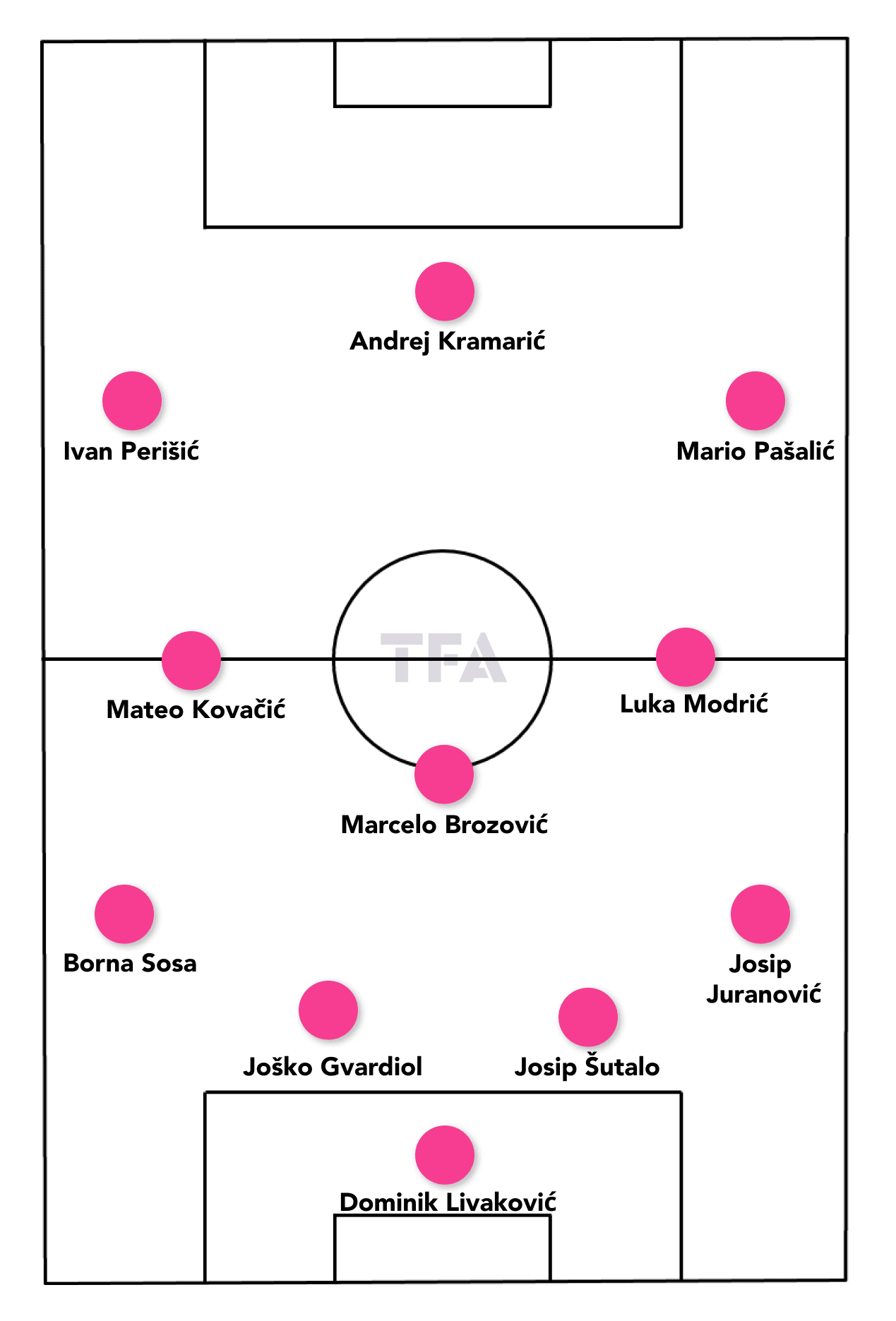
As for the starting lineup itself, this is where it gets tricky for both us to predict and Dalić to choose. The goalkeeper position is arguably one of the weakest links of this otherwise impressive squad. Both Dominik Livaković and Ivica Ivušić are likely to find themselves between the sticks and, truthfully, both offer similar levels of quality, on and off the ball. At this point, however, we see Livaković as more likely to be given the nod due to his superior experience.
When it comes to the backline, the youth tandem of Gvardiol and Šutalo seems the way to go given Croatia’s possession-based style of play. Both defenders are strong on the ball and will aid the team’s build-up phase greatly. When it comes to the full-backs, Borna Sosa is Croatia’s high-flying option whose impact out wide means he’s more likely to start ahead of his more defensive namesake, Borna Barišić. Josip Juranović offers a similarly more offensive output than his ‘rival’, Josip Stanišić and could, in our eyes, get the nod for that same reason.
The midfield is Croatia’s bread and butter. We don’t need to spend too long on the incredible trident of Brozović, Modrić and Kovačić but one potential worry for Dalić heading into the tournament is his pivot’s fitness. Brozović’s injury puts the whole system in jeopardy and while he may still recover in time for the event, it remains to be seen how Dalić decides to tackle his absence, should it come to that.
There are a couple of options available with Kristijan Jakić probably being the likeliest to fill Inter star’s boots. However, the defensive midfielder position is definitely among Croatia’s weak links as the quality plummets with Brozović out of the picture. All of Jakić, Nikola Moro and Josip Mišić have their strengths and could do the job decently well but none are as good as the player they’d be replacing.
Finally, we have the forward line. Croatia’s firepower is impressive but the lack of a clear number 9 in the squad is a reason for concern. We’ve decided to go with Andrej Kramarić but the outlook of this team changes completely depending on who starts at centre-forward. Kramarić is the roaming, false 9 type of striker while someone like Ante Budimir offers a more traditional blueprint for the position.
There’s always an option of Bruno Petković (should he get the call-up) and Marko Livaja, who’s been excellent domestically, but at this point, it’s very difficult to say for sure who’s going to start. A similar thing can be said for the right-wing position as all of Mario Pašalić, Nikola Vlašić and Lovro Majer have their unique traits but also change the system with their inclusions. The only constant is, therefore, Perišić on the left. The veteran is among Croatia’s most important players and will surely continue to have a prominent role in Qatar as well.
Attacking phase
So how do Croatia attack? Before delving into the tactics, let’s first consult the stats to determine their general style of play. Our pizza chart compares Croatia to the other teams competing in the World Cup and then gives us their percentile rankings for each of the selected categories. This specific graph focuses on Vatreni’s attacking power.
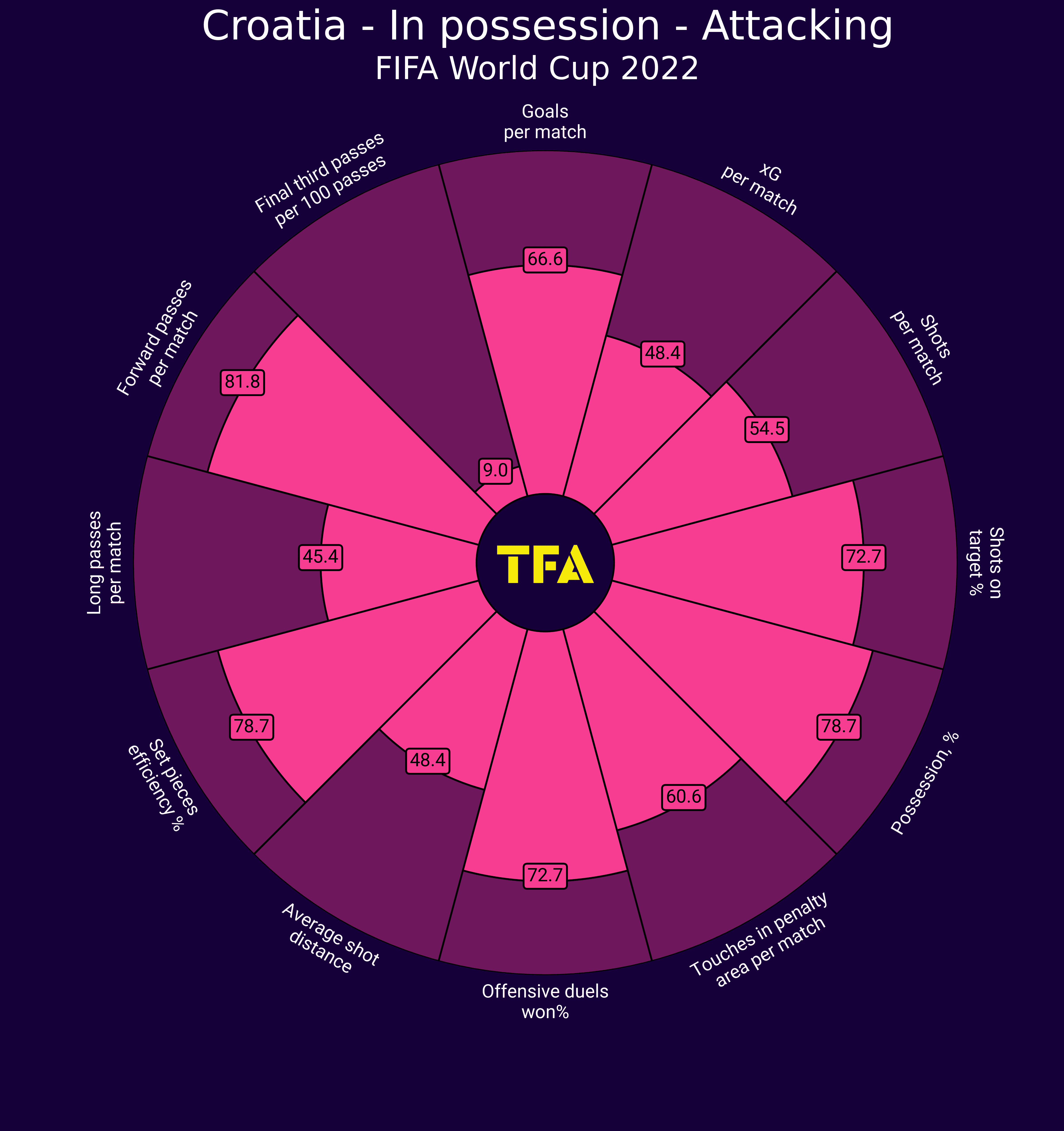
As we can see here, Croatia are a formidable force in possession of the ball. We can’t say they top any of the charts but they do come close in several categories such as forward passes per match, set piece efficiency and possession. This on its own is a great outlook of their general tendencies in attack. Croatia like to have the ball but are not afraid to be very direct with it and hurt teams on the break and through set pieces. Given the quality they have, especially in midfield, it doesn’t surprise that they can indeed hold onto the ball and then quickly and efficiently move it up the pitch.
But the fact they win so many offensive duels tells us they are also combative, physical and can overpower teams closer to the penalty area. Their 60.6 percentile ranking in touches in the box per match is both a testament to the squad’s proficiency with the ball and a nose for finding great pockets to exploit within the danger zones. They may not always score goals galore but are more than capable of hurting practically anyone they face. Case in point being their 1-0 victory over France in the Nations League. But what are some of their distinct traits in possession when it comes to tactics?
Dalić has already confirmed Croatia are likely to stick with their 4-2-3-1 or a 4-3-3 formation, depending on the personnel available and chosen. This is why we kept emphasising the point of players directly affecting the system deployed. Brozović’s absence may force Croatia into a different structure altogether while the same can be said for the choice of their right-winger. On paper, however, none of the preferred choices for that position are natural wide wingers. Whether that’s Pašalić, Vlašić or even Kramarić when deployed out wide, they all tend to drift inside and roam the final third.
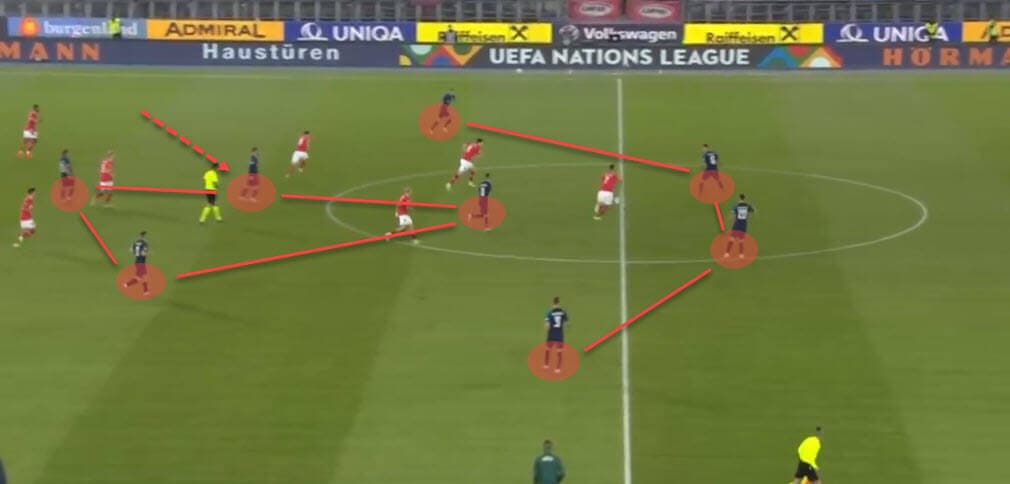
Take this sequence as a great example of exactly that. Croatia will generally build in a 2-1 shape but depending on the opposition’s press, they will drop an additional midfielder to make it a 2-2 and that will also largely affect the height of the full-backs’ lines. Often, the full-backs will be deployed in an asymmetrical shape where one aids the build-up while the other creates an isolation higher up the pitch. Given both of their full-backs are likely to be highly offensive should both Sosa and Juranović start, which we predict will be the case, this can be a major offensive weapon for Vatreni.
In this example, however, we see them overload the middle of the pitch. This is done because it plays to their strengths; most of their star power comes from the middle of the pitch and this is where they can dominate even the best of teams. But for a possession-based team, Croatia can be very direct in their approach too. This is generally due to two things: the goalkeeper profiles and the excellence in the delivery of their midfielders, especially Modrić. Both Livaković and Ivušić are quite similar in this regard and picking one over the other shouldn’t, in theory at least, affect their style too much. Seeing them go long from goal-kick or open play won’t be a surprise, especially if they opt to play with a target-man up front such as Budimir or even Petković. But being direct doesn’t only stem from goalkeeper tendencies but also their in-possession traits.
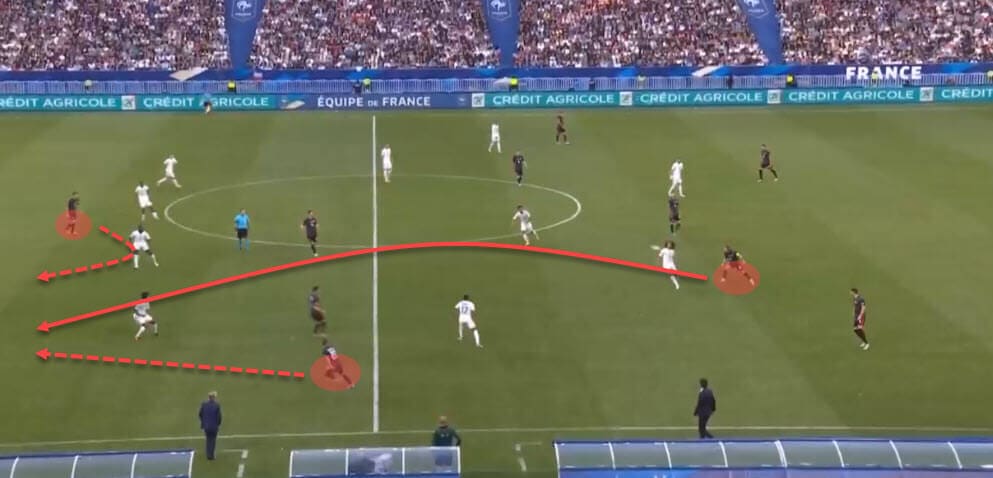
It’s not uncommon for Modrić to drop deep and then deploy either a line-breaking pass into space or simply a lofted ball over the top, both of which complement the runners Croatia have in their arsenal. The example here is a perfect demonstration of such a scenario. Interestingly, it’s also a sequence that ultimately ends in a goal for Dalić’s squad. Leaving a player of Modrić’s calibre with ample time and space on the ball is something not even the best of teams will be able to afford, come the World Cup in Qatar.
The final thing we need to address when it comes to Croatia’s attacking tactics is their ability to create threat through their quality in tight spaces. Even though the data doesn’t always reflect that, Vatreni are extremely technical, albeit mostly due to their midfield. The directness of their approach aside, Croatia can and will dismantle teams through smart and quick interplay down the middle before an inevitable ejection of the wingers.
Dalić may not be a master tactician but he needn’t be when he’s got such incredible talent at his disposal. The following example shows us that perfectly.
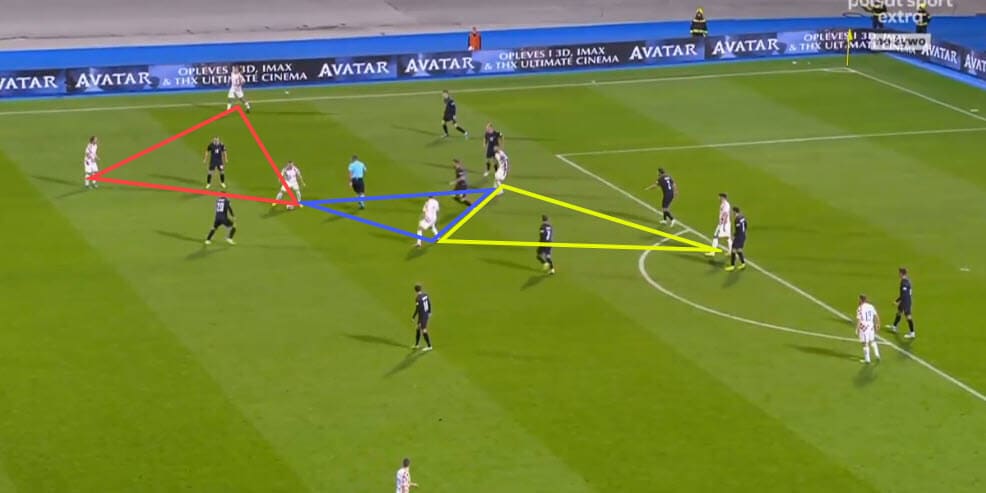
Most of Croatia’s attacking sequences do end up in a delivery from out wide but the interplay also often originates down the middle where they can ‘out-tech’ teams to a ridiculous extent. A lot of it is due to their immense quality on an individual level but they are also quite disciplined and well-structured.
In attack, Croatia are a force to be reckoned with.
Defensive phase
Moving onto Croatia’s defensive tactics, we’ll follow the same blueprint once again. Before doing a more in-depth analysis of the structures and tendencies, let’s first get data out of the way. Just like we had in the section before this one, here is a pizza chart again. Just to reiterate – the percentile rankings represent Croatia’s results in their respective defensive categories against other World Cup teams. The rankings are also not reversed, meaning lower PPDA means better performance in that category.
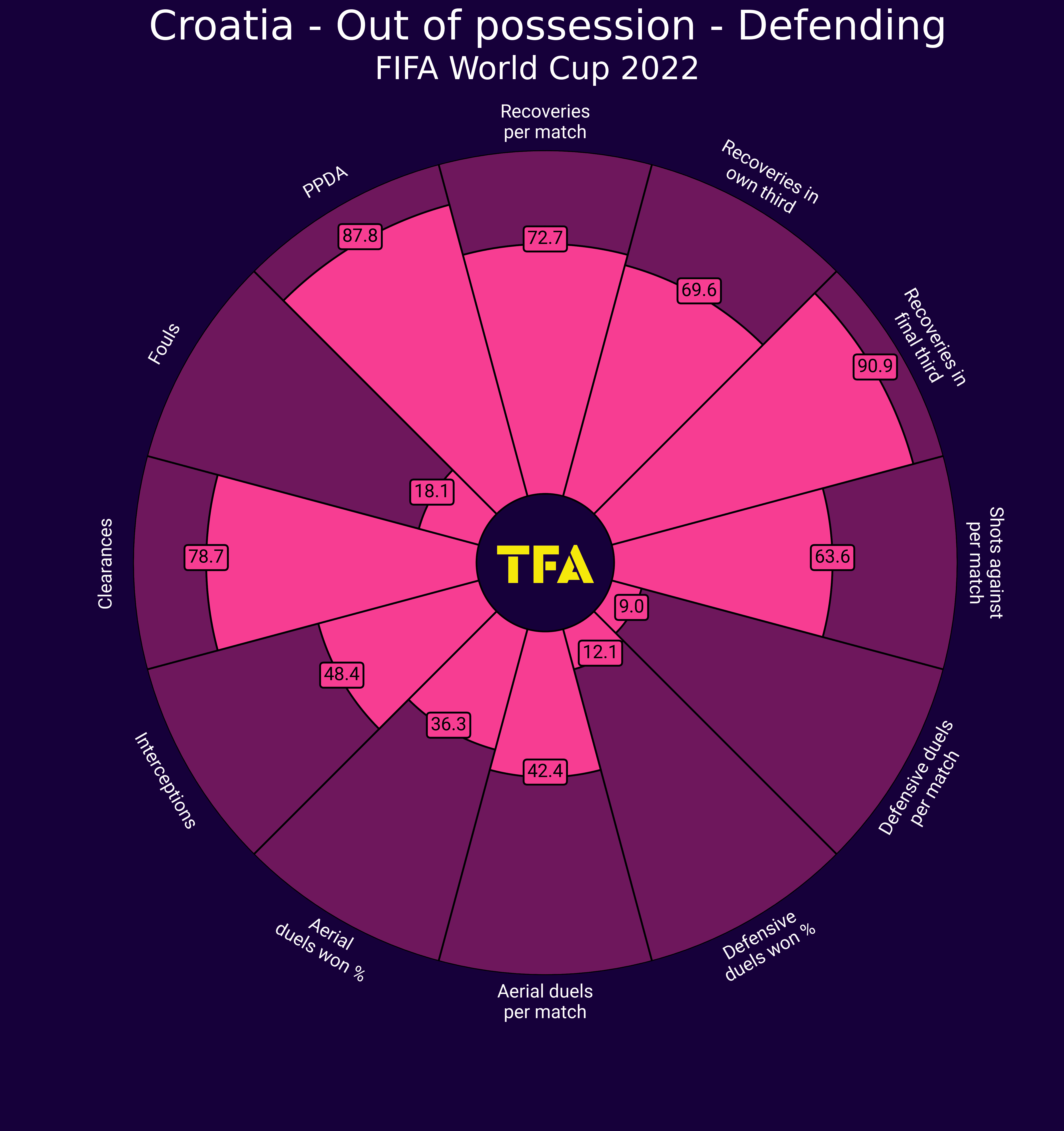
Looking at the pizza chart, we can conclude a couple of things. Firstly, despite their high success in final-third recoveries, Croatia are not a high-pressing side. Yes, they can and will generate chances by defending high but are more comfortable defending in a slightly deeper mid-to-low block. The high PPDA (passes allowed per defensive action) percentile ranking, in this case, means they will generally allow the opposition ample time on the ball, rather congesting the deeper areas than flooding the other team’s half with players.
It’s quite interesting to note, however, that they are still pretty intense in both the middle and the final third of the pitch. Given their PPDA numbers, this is still very much a dosed aggression but a successful one nonetheless. So we can say Croatia’s pressing is not about quantity but rather quality. More concerning, however, is the low win percentage in duels across the board. This is where the low numbers do give cause for alarm as their shots against also leave a lot to be desired. When combined, this lacklustre defensive duelling paired with a low foul count and not stopping the opposition from shooting can become an issue. But let’s explore their actual defensive tactics next.
As mentioned earlier, Dalić’s troops will sit back in a deep and compact block, often assuming a 4-5-1/4-1-4-1 or a 4-4-2 shape, depending on whether they’re more aggressive or conservative.
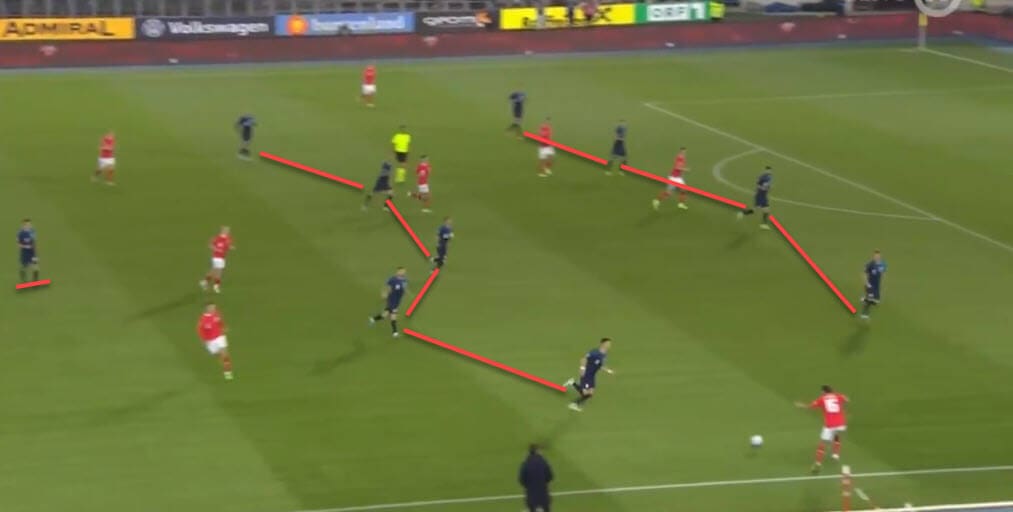
This shape aims to optimise their coverage off the ball while also congesting the danger zones on the pitch. Leaving the striker up front is also a way for Croatia to quickly transition from defence to attack but more on that later in this tactical analysis. The deep block varies from a 4-5-1, 4-1-4-1 to a 4-4-2 and the difference is usually in the way the midfielders are deployed. In the first scenario, the wingers will drop deeper and the midfielders will be deployed roughly at the same height. However, this often morphs into a 4-1-4-1 if the pivot is dragged deeper through marking.
If Croatia decide to push up and disrupt the build-up without aggressively pressing, they will usually instruct one of the midfielders to position himself next to the striker, creating a make-shift 4-4-2 structure. This can then further evolve into a 4-3-3 shape when trying to recover the ball high. In terms of pressing, Dalić generally goes for a heavy man-marking system, sometimes matching the opposition player-for-player.
We can actually see a very similar scenario in the following example.
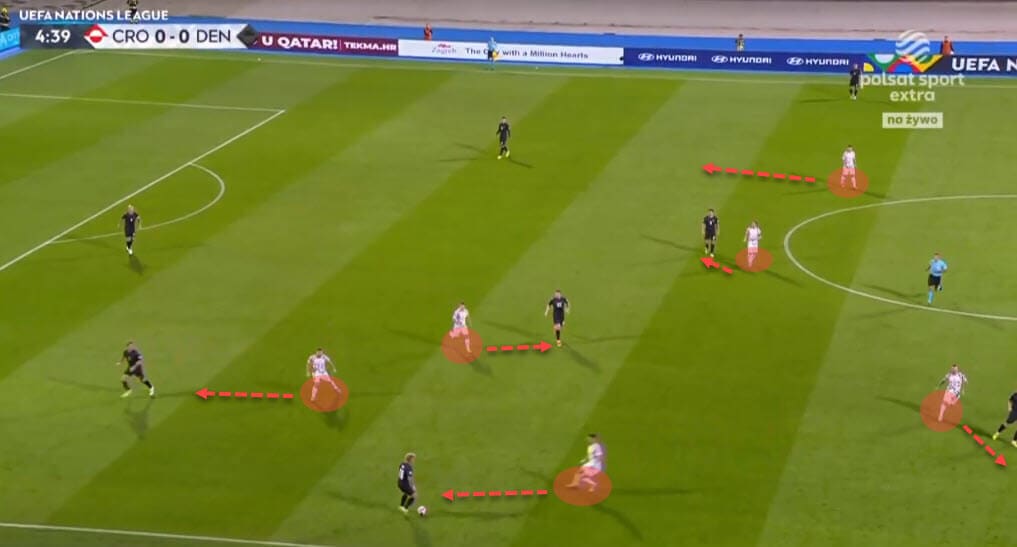
This man-marking approach does come with its pros and cons, of course. When executed well, it yields great results in terms of ball recovery, as we’ll soon see. However, it’s also highly susceptible to manipulation and the very best teams will know how to use it against the Croats. But given their great recovery numbers despite not being an overly aggressive pressing side, we can conclude they are calculated and well-drilled in what they do.
The final image we’ll analyse in their defensive tactics are the recoveries they made in their last four games in the Nations League. With the exception of the clash against France (bottom-left image), we see Croatia were most aggressive in the middle third of the pitch and that’s where the majority of their recoveries come from.
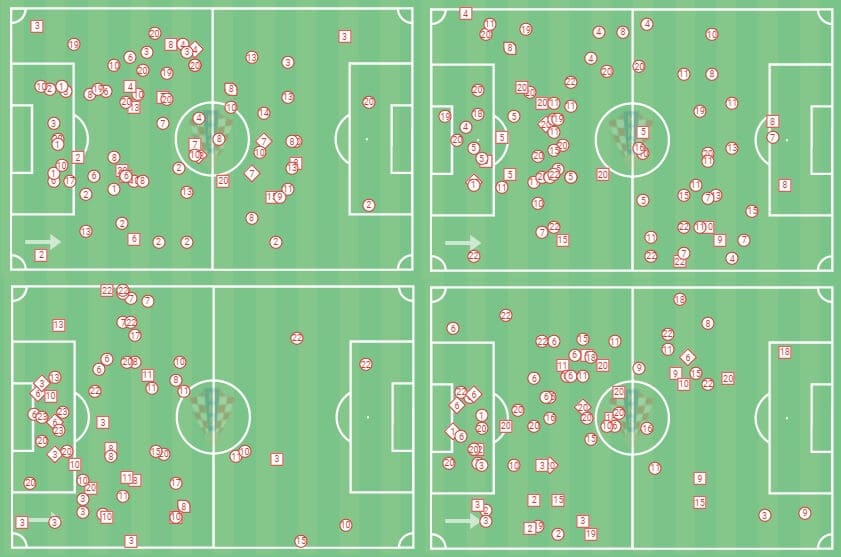
Very rarely do they actually go all the way to the final third or even the opposition’s box but as already explained, when they do, they’re often very effective.
Transitions
In this final tactics section of this analysis, we’ll shortly discuss Croatia’s transitional prowess. As alluded to before, despite being a team that enjoys having the ball, Vatreni can be quite direct in their approach. Given the profiles of their players, we can also state it suits them nicely.
Just like in almost any phase of the game, midfielders are key to Croatia’s transition tactics. Both Modrić and Kovačić are excellent carriers of the ball while also possessing a great passing repertoire, of course, the former player much more so than the latter. The same can be said for Brozović, who, despite a more conservative pivot role, is a great first and second-phase distributor with an impressive engine. It stands to reason then that Croatia break quickly and directly through their midfielders whenever the chance arises.
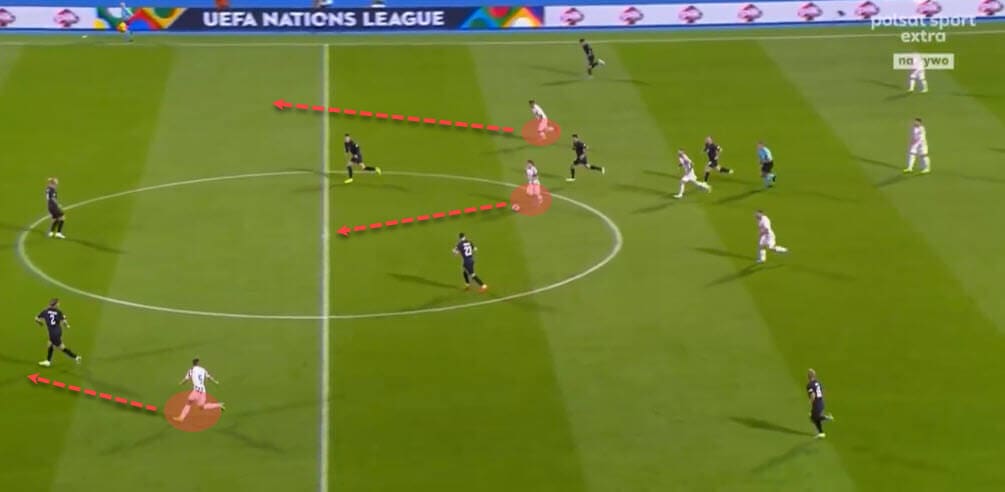
It’s not uncommon to see Croatia start their transitions by winning the ball in the middle third of the pitch, where they are undeniably most aggressive, and then having either Modrić or Kovačić carry it upfield before ejecting runners into space out wide. You can see one such sequence here as well with Modrić unsurprisingly taking the lead role. Having wingers such as Perišić to aim for, Croatia can always pose a threat in transitions.
Another option in attacking transitions presents itself in the form of their centre-forward. Whether they deploy someone like Budimir in a traditional striker mould or someone like Kramarić or Petković in the freer, modern outlook, the link-up with the player up top is key. We can expect layoffs regardless of the type of no.9 Dalić picks for his squad and this once again goes hand in hand with the runners they will get from deep.
Moving onto defensive transition tactics, it all comes from coordinated gegenpressing in the middle third and providing the team with a safety net should that fail.
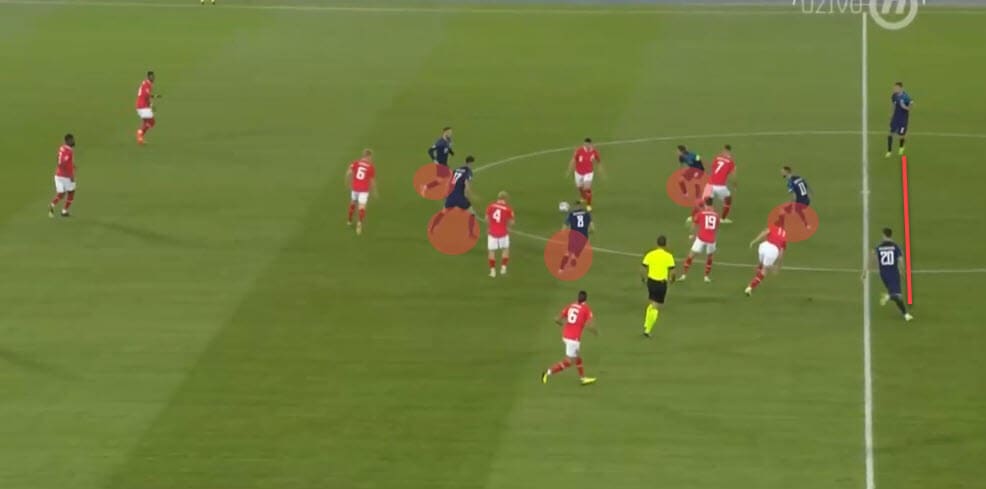
Croatia will often hunt for the ball relentlessly in the first couple of seconds of losing possession so it’s common to see them swarm the area, pushing up with numbers. Of course, should the opposition resist their efforts, they’ll quickly revert to their deep block. If, however, the other team manages to break into a counter-attack themselves, Croatia are hard-working in tracking back, which may make or break their defensive efforts the deeper they go in the tournament.
Attackers
In the following sections of our tactical analysis, we’ll dissect Croatia’s squad line by line, starting with the forwards. Even though they aren’t lacking firepower, there are question marks that can be raised for both their striker and right-wing positions. The former, of course, being one of the major ‘flaws’ (or just conundrums?) of an otherwise well-assembled team. As things currently stand, we don’t know who Dalić is going to pick as his starting no.9 once the World Cup rolls in.
In our predicted XI section, we decided to go with Kramarić but to call him a striker may be a bit of a stretch. He is a forward but not exactly a no.9 of the traditional mould. He likes to drift, roam and combine in deeper and/or wider areas, making him more of an inverted forward or a second striker. However, he can and already has been used in the centre, with varying levels of success. Sure, Croatia would have to be far more combinatory down the middle and keep those direct sequences to a minimum but that’s what possession-based teams do best. And Croatia are a possession-based team.
Along the same lines, Dalić could opt for Petković, albeit it still remains to be seen whether the Dinamo Zagreb star will even travel with the team to Qatar. His back-to-goal quality paired with excellent technical traits make him a true nuisance for the opposition defence. However, Petković blows hot and cold, which means he ranges from unplayable to invisible depending on how the mood strikes him that day. Then there’s Budimir who might be Croatia’s best option for a traditional striker.
The LaLiga centre-forward has an eye for goal, can be used as a target-man and is excellent in the air too, playing to Croatia’s set-piece proficiency. Not only that but he is by far their best defender from the front when it comes to pressing and shutting off passing lanes. If Croatia were to be more aggressive off the ball and suffocate the opposition’s build-up phase, going with Budimir might be their best bet.
The last option would be going with Hajduk Split’s Livaja but despite an excellent domestic season and his undeniable quality, it’s likely we see him in a rotational role coming off the bench.
Midfielders
The crème de la crème of Croatia’s squad undoubtedly lies in their midfield line. This is where their individual quality can break any game and tip the tides in their favour. If everyone was fit and firing, there would be no doubt about the starting trident of Brozović, Modrić and Kovačić. However, they’re not all fit. At least not as of yet. Having sustained an unlucky injury just before the World Cup, Brozović is still on the mend.
Considering there is no other clear option for that pivot position, it poses a huge question to Dalić: who is going to replace the anchor of the team? Let’s lay out the option and try and predict the outcome too. We also have to state there is still a chance Brozović features so that’s why we’ve decided to plug him into our predicted XI. However, on the off chance he doesn’t, the first name that comes to mind when discussing his replacement would be Jakić.
He is the safest option as he’d provide the team with more defensive coverage while also being the more conservative option in possession. Of course, given Croatia’s tendency to at least try and hold onto the ball, having a pivot who’s less proficient in possession could be a cause for concern. That’s where we come to Mišić, a more technical option who can aid the build-up significantly better but would fall short when compared to Jakić’s defensive quality. Moro would be the last option as a project player but would Dalić be so brave to ‘risk’ having a largely inexperienced player at such a high level playing such a crucial role in the squad? For now, that seems less likely.
When it comes to the other two midfielders, provided they’re also fit, there is no question that both Modrić and Kovačić will feature, on the right and left side of the trident respectively. Croatia’s midfield quality is indeed off the charts but it’s also true that it dwindles significantly when you go beyond the starting XI personnel. That is a testament to their best midfielders’ prominence but also a potential flaw for Dalić to look out for.
Defenders
Finally, we have to address the backline, including the goalkeepers. Let’s cover the men between the sticks first. Between Livaković and Ivušić, the choice may not be crystal clear and this has been an ongoing debate in Croatian media for a long time now. However, the answer to that conundrum really isn’t a simple one. On paper, both goalies are painfully close to each other in terms of quality and both offer similar traits to the team when selected. The only difference would be in the experience.
Livaković has already had the chance to be Croatia’s no.1 on the biggest of stages and this might be the aspect that finally tips the choice in his favour. At the end of the day, considering there isn’t much to separate them in quality, we couldn’t really blame Dalić for going for experience. This is the World Cup after all.
When it comes to the centre-back tandem, going with Gvardiol and Šutalo makes the most sense given Croatia’s system and style of play. Both are excellent in progression from the back and both are also quite young. Gvardiol, of course, is also perhaps Croatia’s most valuable player at the moment and undeniably one of their biggest prospects as of right now. There could be an option of playing someone like Martin Erlić next to Gvardiol, which would give the backline more defensive solidity and experience, sacrificing some progression in the process. However, with Dalić emphasising the need for Croatia to be a possession-heavy side, it’s difficult to see Šutalo dropped for anyone else in that squad.
We shouldn’t forget that Dalić also has the option of deploying Lovren and/or Vida but there are better, younger and more reliable options out there so the veterans may have to get used to a significantly smaller role in Qatar.
To round off this section of our tactical analysis, let’s quickly address the full-backs. As stated earlier, Sosa and Juranović could both get a nod ahead of their respective counterparts simply due to their more offensive nature. Croatia need attacking full-backs to either complement the movement of their wingers, as predominantly seen on the right, or to double down on the wide delivery threat, as seen on the left.
For those reasons, they are more than likely to be Dalić’s preferred choices once the tournament starts.
Key player
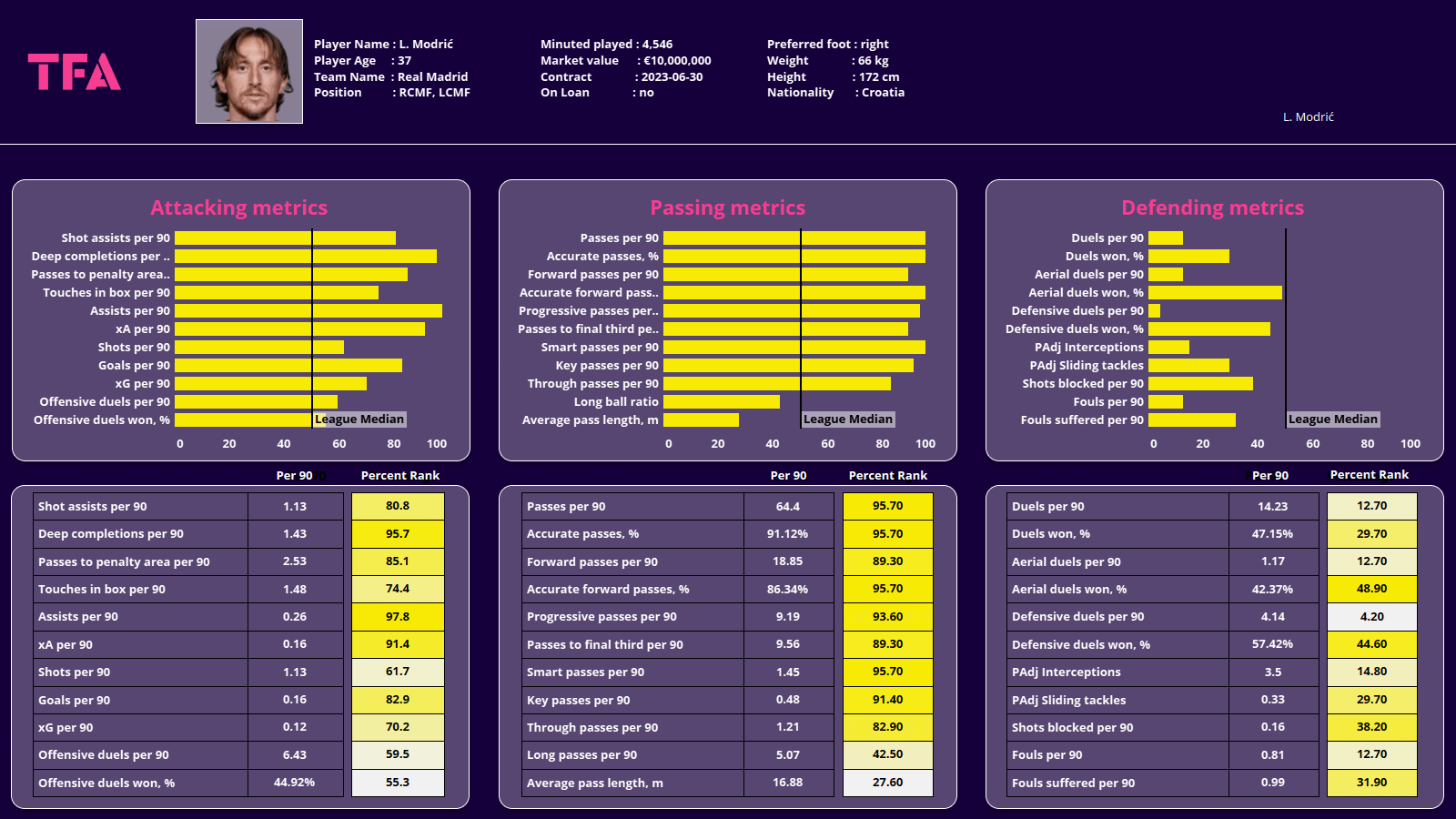
Was there ever any doubt? Even at the ‘tender’ age of 37, Modrić is still Croatia’s best and most influential player. The captain will be looking to bow out of the national team with a bang and what better way to do it than to have one last go at the big trophy?
Modrić the player needs little to no introduction. He’s an all-action midfielder who glides across the pitch as if he was 17, not 37. His attacking, progression and retaining capacity are off the charts and we can see he regularly tops almost all the on-the-ball metrics as well. There aren’t many other players at this World Cup who can go toe-to-toe with the Croatian maestro as he’s basically the best at what he does. And he does it all. Well, almost.
The Real Madrid superstar might not be the best and most active defender in the tournament but that doesn’t mean he’s a liability out of possession. Despite being 37, Modrić still has an impressive engine and it’s his experience and footballing IQ that make him a competent defender too, more so than his physical attributes.
How far Croatia can and will go largely depends on the form of this little man. And judging by his season so far, both for club and country, Modrić is as good as he ever was.
Tournament prediction
The 2018 silver medalists are back for more in Qatar. It’s very difficult to predict how far they will go because they could just as easily reach the final again as they are to somehow implode halfway through the tournament. They are the dark horses in every sense of the word as you cannot really say they’re among the favourites but you also cannot really say they won’t win the whole thing either.
But predictions we promised so predictions we’ll provide. Given their potential opponents and the quality of group-stage opposition, reaching the quarter-finals and going beyond that is possible and desirable for Vatreni. However, if Brozović recovers in time, Modrić retains his top form and Dalić’s troops get lady luck on their side again, the quarters are the very minimum they should achieve.

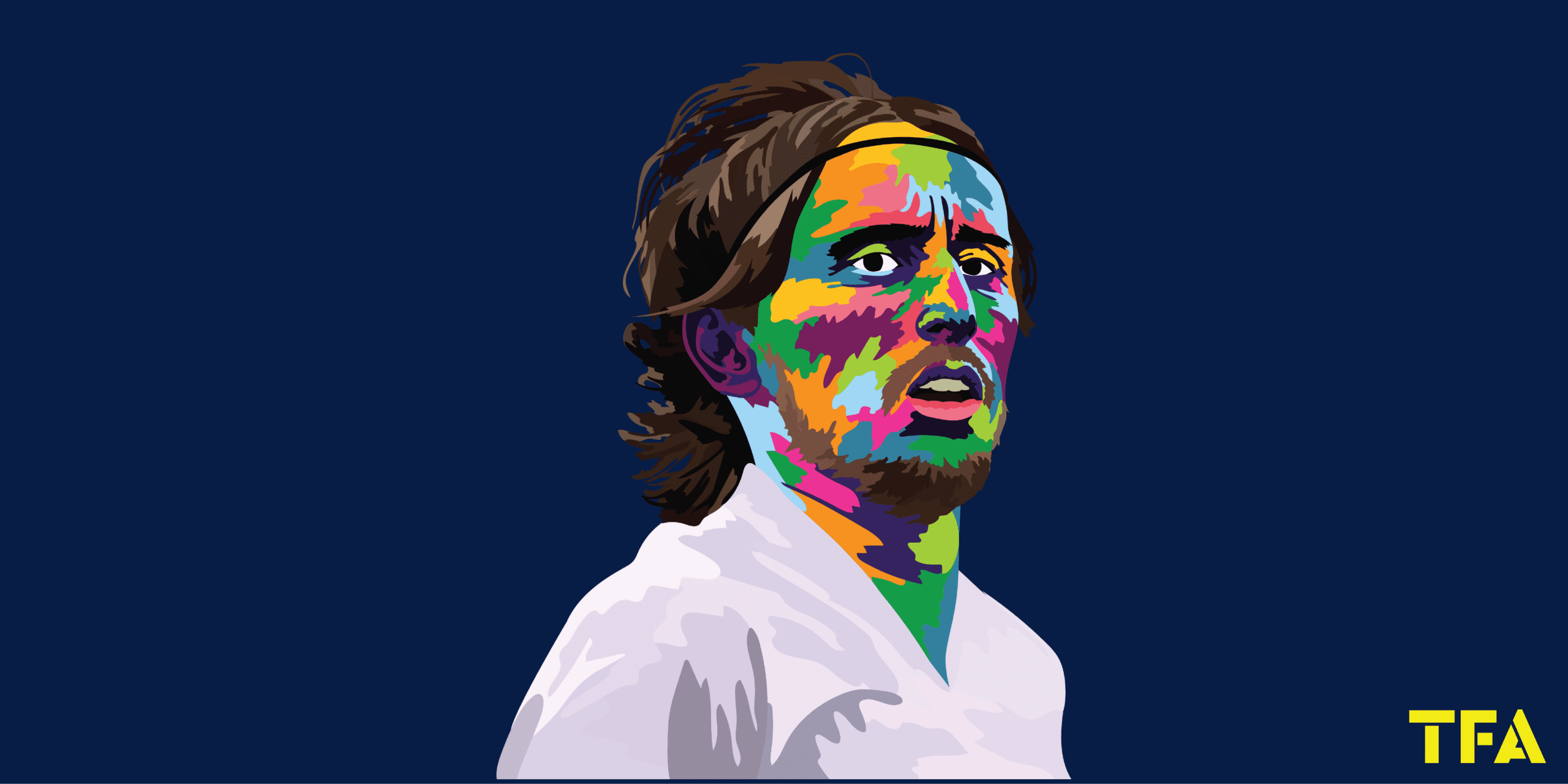




Comments